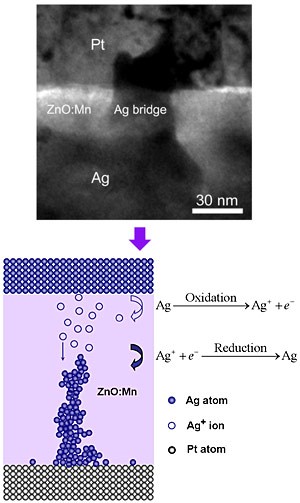
Non-volatile memory: silver switches
- Select a language for the TTS:
- UK English Female
- UK English Male
- US English Female
- US English Male
- Australian Female
- Australian Male
- Language selected: (auto detect) - EN
Play all audios:
A highly efficient memory cell based on resistive switching is produced at room temperature using a simple technique. The future of information storage relies on the development of small,
fast and non-volatile memory elements. Non-volatile memory such as flash memory, however, remains slow in comparison to volatile random access memory, and has reached its feature shrinkage
limit. A possible and promising approach to the development of faster non-volatile memory is represented by resistive-switching random access memory, which is based on the characteristic of
certain materials to switch between high- and low-resistance states in response to an electric signal. A team of researchers1 in China has now succeeded in fabricating a highly efficient
resistive-switching element consisting of a manganese-doped zinc-oxide (ZnO) layer sandwiched between silver and platinum contacts. The result was achieved using a simple technique that can
be performed entirely at room temperature. For Feng Pan from Tsinghua University, one of the researchers involved in the project, this is very significant. “It warrants the compatibility of
the new route with conventional CMOS processes and provides a potential of stacking the memory cells in three-dimensional structures,” he says. The structure exhibits resistive switching
with a very high ratio (107) between the resistances of the two states. In addition, the team demonstrated that it is possible to switch from one resistive state to the other by applying a
voltage pulse of as short as five nanoseconds. Fig. 1: Transmission electron microscope image revealing the presence of a silver bridge (top) and the proposed mechanism for reversible onset
of the high-conductivity state (bottom). But what is the actual mechanism for resistive switching? For Pan and co-workers, the application of a sufficiently high voltage gave rise to a redox
reaction that led to the reversible formation of conductive silver filaments — or bridges — between the two contacts. By applying external biases with opposite polarities, these silver
bridges could be repeatedly connected and ruptured, thus switching between the high- and low-resistance states. This hypothesis was confirmed by careful structural analysis, which revealed
the presence of silver bridges in structures switched to the low-resistance state (Fig. 1). “This work exploits promising resistive switching phenomena in a highly popular material ZnO, and
establishes the mechanism via a direct method”, says Pan. “Our subsequent research interests will focus on integration of the memory cells and further understanding of the physics in
resistive memories.” REFERENCES * Yang, Y.C., Pan, F., Liu, Q., Liu, M. & Zeng, F. Fully room-temperature-fabricated nonvolatile resistive memory for ultrafast and high-density memory
application. _Nano Lett._ 9, 1636 (2009). Article CAS Google Scholar Download references ADDITIONAL INFORMATION This research highlight has been approved by the author of the original
article and all empirical data contained within has been provided by said author. RIGHTS AND PERMISSIONS Reprints and permissions ABOUT THIS ARTICLE CITE THIS ARTICLE Non-volatile memory:
Silver switches. _NPG Asia Mater_ (2009). https://doi.org/10.1038/asiamat.2009.215 Download citation * Published: 15 June 2009 * DOI: https://doi.org/10.1038/asiamat.2009.215 SHARE THIS
ARTICLE Anyone you share the following link with will be able to read this content: Get shareable link Sorry, a shareable link is not currently available for this article. Copy to clipboard
Provided by the Springer Nature SharedIt content-sharing initiative